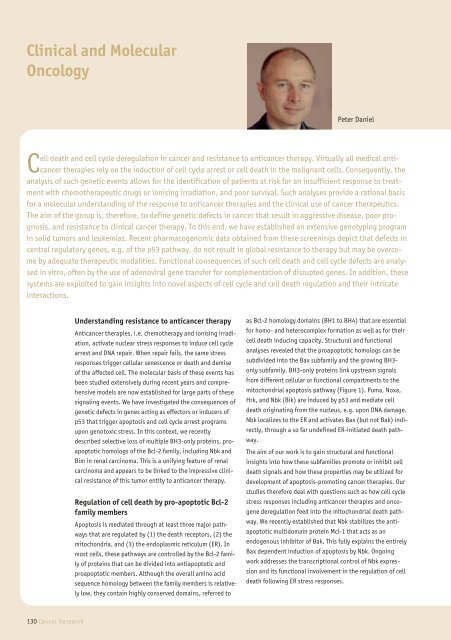of the Max - MDC
of the Max - MDC
of the Max - MDC
Create successful ePaper yourself
Turn your PDF publications into a flip-book with our unique Google optimized e-Paper software.
Clinical and Molecular<br />
Oncology<br />
Peter Daniel<br />
Cell death and cell cycle deregulation in cancer and resistance to anticancer <strong>the</strong>rapy. Virtually all medical anticancer<br />
<strong>the</strong>rapies rely on <strong>the</strong> induction <strong>of</strong> cell cycle arrest or cell death in <strong>the</strong> malignant cells. Consequently, <strong>the</strong><br />
analysis <strong>of</strong> such genetic events allows for <strong>the</strong> identification <strong>of</strong> patients at risk for an insufficient response to treatment<br />
with chemo<strong>the</strong>rapeutic drugs or ionising irradiation, and poor survival. Such analyses provide a rational basis<br />
for a molecular understanding <strong>of</strong> <strong>the</strong> response to anticancer <strong>the</strong>rapies and <strong>the</strong> clinical use <strong>of</strong> cancer <strong>the</strong>rapeutics.<br />
The aim <strong>of</strong> <strong>the</strong> group is, <strong>the</strong>refore, to define genetic defects in cancer that result in aggressive disease, poor prognosis,<br />
and resistance to clinical cancer <strong>the</strong>rapy. To this end, we have established an extensive genotyping program<br />
in solid tumors and leukemias. Recent pharmacogenomic data obtained from <strong>the</strong>se screenings depict that defects in<br />
central regulatory genes, e.g. <strong>of</strong> <strong>the</strong> p53 pathway, do not result in global resistance to <strong>the</strong>rapy but may be overcome<br />
by adequate <strong>the</strong>rapeutic modalities. Functional consequences <strong>of</strong> such cell death and cell cycle defects are analysed<br />
in vitro, <strong>of</strong>ten by <strong>the</strong> use <strong>of</strong> adenoviral gene transfer for complementation <strong>of</strong> disrupted genes. In addition, <strong>the</strong>se<br />
systems are exploited to gain insights into novel aspects <strong>of</strong> cell cycle and cell death regulation and <strong>the</strong>ir intricate<br />
interactions.<br />
Understanding resistance to anticancer <strong>the</strong>rapy<br />
Anticancer <strong>the</strong>rapies, i.e. chemo<strong>the</strong>rapy and ionising irradiation,<br />
activate nuclear stress responses to induce cell cycle<br />
arrest and DNA repair. When repair fails, <strong>the</strong> same stress<br />
responses trigger cellular senescence or death and demise<br />
<strong>of</strong> <strong>the</strong> affected cell. The molecular basis <strong>of</strong> <strong>the</strong>se events has<br />
been studied extensively during recent years and comprehensive<br />
models are now established for large parts <strong>of</strong> <strong>the</strong>se<br />
signaling events. We have investigated <strong>the</strong> consequences <strong>of</strong><br />
genetic defects in genes acting as effectors or inducers <strong>of</strong><br />
p53 that trigger apoptosis and cell cycle arrest programs<br />
upon genotoxic stress. In this context, we recently<br />
described selective loss <strong>of</strong> multiple BH3-only proteins, proapoptotic<br />
homologs <strong>of</strong> <strong>the</strong> Bcl-2 family, including Nbk and<br />
Bim in renal carcinoma. This is a unifying feature <strong>of</strong> renal<br />
carcinoma and appears to be linked to <strong>the</strong> impressive clinical<br />
resistance <strong>of</strong> this tumor entity to anticancer <strong>the</strong>rapy.<br />
Regulation <strong>of</strong> cell death by pro-apoptotic Bcl-2<br />
family members<br />
Apoptosis is mediated through at least three major pathways<br />
that are regulated by (1) <strong>the</strong> death receptors, (2) <strong>the</strong><br />
mitochondria, and (3) <strong>the</strong> endoplasmic reticulum (ER). In<br />
most cells, <strong>the</strong>se pathways are controlled by <strong>the</strong> Bcl-2 family<br />
<strong>of</strong> proteins that can be divided into antiapoptotic and<br />
proapoptotic members. Although <strong>the</strong> overall amino acid<br />
sequence homology between <strong>the</strong> family members is relatively<br />
low, <strong>the</strong>y contain highly conserved domains, referred to<br />
as Bcl-2 homology domains (BH1 to BH4) that are essential<br />
for homo- and heterocomplex formation as well as for <strong>the</strong>ir<br />
cell death inducing capacity. Structural and functional<br />
analyses revealed that <strong>the</strong> proapoptotic homologs can be<br />
subdivided into <strong>the</strong> Bax subfamily and <strong>the</strong> growing BH3-<br />
only subfamily. BH3-only proteins link upstream signals<br />
from different cellular or functional compartments to <strong>the</strong><br />
mitochondrial apoptosis pathway (Figure 1). Puma, Noxa,<br />
Hrk, and Nbk (Bik) are induced by p53 and mediate cell<br />
death originating from <strong>the</strong> nucleus, e.g. upon DNA damage.<br />
Nbk localizes to <strong>the</strong> ER and activates Bax (but not Bak) indirectly,<br />
through a so far undefined ER-initiated death pathway.<br />
The aim <strong>of</strong> our work is to gain structural and functional<br />
insights into how <strong>the</strong>se subfamilies promote or inhibit cell<br />
death signals and how <strong>the</strong>se properties may be utilized for<br />
development <strong>of</strong> apoptosis-promoting cancer <strong>the</strong>rapies. Our<br />
studies <strong>the</strong>refore deal with questions such as how cell cycle<br />
stress responses including anticancer <strong>the</strong>rapies and oncogene<br />
deregulation feed into <strong>the</strong> mitochondrial death pathway.<br />
We recently established that Nbk stabilizes <strong>the</strong> antiapoptotic<br />
multidomain protein Mcl-1 that acts as an<br />
endogenous inhibitor <strong>of</strong> Bak. This fully explains <strong>the</strong> entirely<br />
Bax dependent induction <strong>of</strong> apoptosis by Nbk. Ongoing<br />
work addresses <strong>the</strong> transcriptional control <strong>of</strong> Nbk expression<br />
and its functional involvement in <strong>the</strong> regulation <strong>of</strong> cell<br />
death following ER stress responses.<br />
130 Cancer Research
















